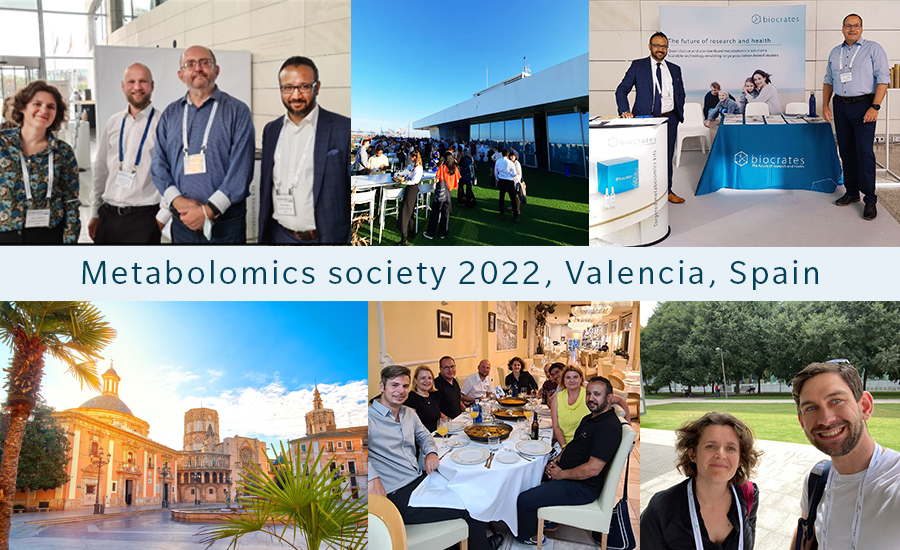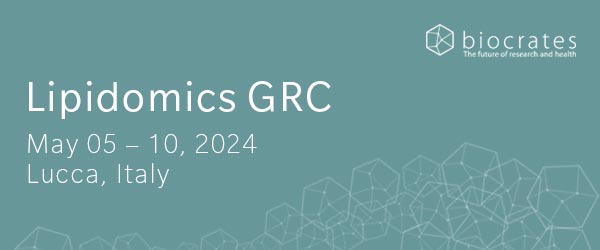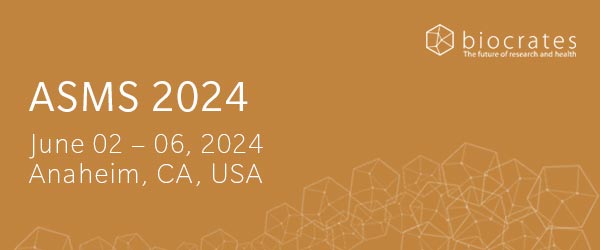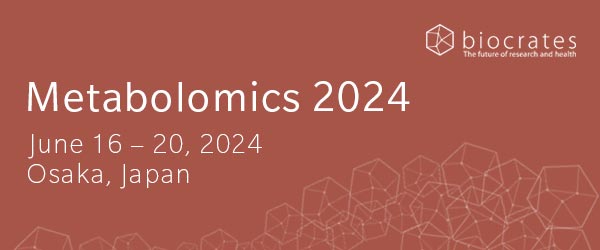Last year, we published “Metabolomics 2021 online” with our top take-aways from the annual meeting of the Metabolomics Society. For obvious reasons, we couldn’t meet in person, but thankfully in-person events are back on the agenda now. This year, I can write not only about the great talks and posters at Metabolomics 2022, but also about the atmosphere, workshops, and face-to-face conversations we enjoyed in Valencia, after keeping our distance for the previous two years. If you missed it, here’s a run-down of my favorite aspects of the event.
In-person conferences are simply the best
Virtual events have been a huge success, allowing us to connect and collaborate from a safe distance and from all corners of the world over the past two years. But if you were there in Valencia, you probably agree that there’s nothing like being together in person. Nothing compares to the feeling of sharing an auditorium with hundreds of attendees (even if wearing a face mask), watching the speakers up close as they deliver their talks, and walking to the microphone to ask your questions while hoping no one notices your shaky hands.
For a start, you wouldn’t have caught the scent or taste of the delicious finger food over Zoom – from traditional cured ham and cheese to more elaborate creations playing on color, texture and taste like the black cones filled with spicy guacamole and topped with a cube of smoked salmon. You’d also have missed the sunny sponsor booths, which were connected without wall separations for maximum openness. Those who wanted even more of that Spanish sun spent their lunches and most of their breaks on the lawn next to the conference center, with impromptu chit-chats and other merry discussions.
We know that sensory stimulation helps us remember events. So, it’s no surprise that an in-person event, especially when organized with such care for detail and quality, should remain in your memory for a long time. I expect this to be particularly true after being starved of such experiences for so long. Here, I put this theory to the test and list the things I remember most fondly about this short week in Valencia.
Workshops
My plan for this trip was to arrive in Valencia a day and half before the conference began, so I could take in some of the city. Then I saw the workshops’ program. As a learning enthusiast, I enrolled in all the workshops that caught my eye, trading my touristy weekend for a metabolomics binge without a second’s hesitation.
The MetaboAnalyst team led by Jeff Xia did a great job of demonstrating how their platform can perform to help make sense of metabolomic data, with many different analyses. As someone who’s especially interested in the biological interpretation of data, I particularly appreciated Xia’s comment about the opportunities and limits of these tools. After data analysis, pathway analysis and using all the great tools provided on their platform, it’s up to the human being analyzing the data to make sense of the results in the broader context of the experiment.
These workshops were also an opportunity to brush up on my knowledge of spatial metabolomics and network metabolomics. The workshop on the latter was nicely punctuated with thinly vailed references to Douglas Adams’ book, “The Hitchhiker’s Guide to the Galaxy,” by Horst Schirra of Griffith University in Australia. The spatial metabolomics workshop included in-depth discussions of the methods, and a great treat for novices like me: a video of the whole process including sample preparation presented by Christoph Bookmeyer of Universitat Rovira i Virgili in Tarragona, Spain. I finished with an intense and fully packed R session led by Kangni Alemdjrodo of Purdue University, USA, in the workshop on big data machine learning.
In all these workshops, the instructors took the time to prepare demonstrations and mock datasets for us to play and experiment with, giving us the chance to ask relevant questions in person. This really made for high quality workshops that were 100% worth postponing my city adventures for.
Scientific sessions: part 1
With three parallel sessions throughout the four days of the conference, the program was densely packed. If, like me, you wanted to go to almost every talk, you know how much of a dilemma this can be. On the other hand, it allowed more scientists to present their work, which is one of the main roles of such events.
My conference began with the epidemiology session, where the final talk by Rachel Kelly of Harvard Medical School, USA, particularly caught my attention. In her talk, Kelly presented the cloud-based analytical platform available to members of the COMETS consortium, an ever-growing consortium focusing on collaborative work in the metabolomics field. The tool described in the talk allows contributors to the database to perform new and improved analyses of the entire contents of the database. This makes more datasets available for new discoveries on disease etiology, diagnosis and prognosis.
Interlude: What’s your favorite metabolite?
If you are a listener of The Metabolomist podcast, or if you saw me running around the conference center with my microphone, you probably know that I spent a considerable amount of time hunting and interviewing brave scientists about their favorite metabolites. The result is a feature episode of the podcast with 14 interviews that will spark new ideas and get you curious about new pathways.
Scientific sessions: part 2
Next, I joined the session on neurological disorders where, once again, lipids took the spotlight for anyone wanting to understand conditions as broad as Attention Deficit Hyperactivity Disorder or Parkinson’s disease. Two talks caught my attention in this session. First, Tessa Peters from Radboud University Medical Center, the Netherlands, described her application of metabolomics to better understand GLUT1 deficiency syndrome, a genetic disorder that limits glucose uptake in the brain. Using a small cohort of patients affected by this rare disease, Peters and her colleagues identified several oligosaccharides that suggest a role for protein glycosylation in the mechanisms underlying the disease. The session ended with Karel Kalecky of Baylor University, USA, depicting the metabolomic and lipidomic profiles of Parkinson’s disease in human brain tissue samples, including an integration of the results into a well-articulated story that I particularly enjoyed.
My next session was focused on cancer, where the talk by Guro Giskeødegård shone a powerful light on the use of metabolomics to understand long-term effects of treatments on patients. In this study, the outcomes of breast cancer patients who received different treatments were compared to understand how treatment type may affect later risk of cardiovascular disease. This also made for a perfect background to present RM-ASCA+, a multivariate data analysis method for repeated measures. The method combines linear mixed models with visualization for increased interpretability of common dimension reduction techniques such as principal component analysis.
Interlude: my own talk on data interpretation
I also had the pleasure to present at the conference this year. I focused on metabolomic data interpretation and the practical tools I have been developing in the last couple of years. Currently, the most well-known is our podcast, The Metabolomist, that already has four episodes available for streaming on all the usual platforms. If you were at the conference, you probably had the pleasure of listening to me tell you about the podcast and give you one of our gorgeous Metabolomist cards (thanks to those of you who even tweeted about them!). In my talk I also discussed the trials and tribulations of planning and executing a data interpretation project. Many of you came to me after the talk to tell me how this resonated with you, and I am happy to say that I have more helpful tips coming your way very soon. To make sure to get the latest news on this topic, make sure to connect with me on LinkedIn.
Scientific sessions: part 3
Next came the session on metabolic diseases, from obesity to type 2 diabetes and atherosclerosis. The first talk by Susana Alejandra Palma Duran of the Francis Crick Institute, UK, was a great example of what lipidomics of white adipose tissue can tell us about obesity. It’s always fascinating to me how a tissue that is so often considered as waste or excess can hold so much information when investigated with the right tool. The session ended with a presentation on the often overlooked functions of nicotinamide adenine dinucleotide (NAD) by Sofia Moco of the Vrije Universiteit Amsterdam, the Netherlands.
I also caught the talk by Oliver Fiehn of UC Davis, USA, who gave such an engaging account of the characteristics of the small intestine that I wanted to crack open a physiology textbook as soon as I got home. Fiehn went on to describe why it matters to collect sample in the right place in the digestive tract, and his ongoing project developing such tools. I also managed to get in for the last keynote speaker who gave one of my favorite talks of the conference – discussed below.
I should also mention the poster sessions, but honestly, with so much information and no space to write things down, the poster sessions are a blur. Perhaps my sensory-powered memory imprinting was impaired in such a crowded space. I do remember discussing my own poster on the mechanisms underlying major depressive disorder with a few lovely people.
The power of shared experiences
One of my favorite aspects of conferences is to get a sneak peak into the good and bad of research, beyond the veneer of perfection that we all apply on the final submitted paper. Oral presentations at conferences are a great place to learn from both the mistakes and the solutions of others. A great example of this was the closing talk by Coral Barbas of Universidad San Pablo CEU, Spain.
This presentation attracted the most enthusiastic Q&A session by far. And what was the topic? Basically, everything that could go wrong and how to (attempt to) fix it. The examples given in this talk rang so close to the audience’s experiences that you could feel their excitement at the chance to discuss those experiences after the talk.
In closing, I’m happy to have made the trip to Valencia for what was my first in-person conference for a couple of years. I met old and new friends and peers who discussed their work, hopes and struggles, and who encouraged me to continue working towards sharing data interpretation tips with the community. Every time I attend a conference, I know that it was a success one if I travel home filled with enthusiasm and ideas. This was definitely one of those.



